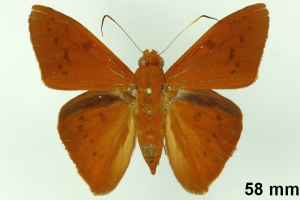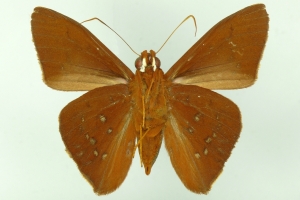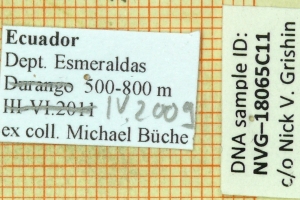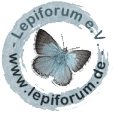

 +1Kontinente:SA
+1Kontinente:SA3. Weitere Informationen
3.1. Taxonomie
Zhang et al. (2024: 13) formulierten: "Genomic analysis of Bungalotis E. Watson, 1893 (type species Papilio midas Cramer, 1775) specimens from western Ecuador reveals that they are sister to Bungalotis corentinus (Plötz, 1882) (type locality in Suriname) but are genetically differentiated from it at the species level (Fig. 12), e.g., their COI barcodes differ by 1.7 % (11 bp), and therefore represent a new species. This new species keys to “Bungalotis diophorus” (D.1.2) in Evans (1952), which is a junior objective synonym of B. corentinus, and differs from it by rusty-reddish color of the dorsal side, more red than yellow (is usually yellower in B. corentinus), larger spots on wings, discal cell spot on the dorsal hindwing is oval, with brown contour, filled with ground color; some postdiscal spots may be paler in the middle; ventral side is browner, spots are larger on the ventral hindwing and filled with more extensive whitish scaling [...]". Sie begründen die Artberechtigung also primär mit einem 1,7 %-COI-Barcoding-Abstand, dann aber auch mit äußeren Unterschieden in Zeichnung und Färbung, sowie schließlich in den (männlichen) Genitalien. Dass ein COI-Barcoding-Abstand von 1,7 % ohne Diskussion als Beweis für Artverschiedenheit gewertet wird, verwundert etwas, zumal man ja nichts über die innerartliche Variabilität der beiden Vergleichsarten weiß. Zusammen mit den "klassischen" Merkmalen ist die Trennung von B. corentinus und B. corentus auf Artebene aber doch die plausibelste Lösung.
(Autor: Erwin Rennwald)
3.2. Faunistik
Nach der Erstbeschreibung: Currently known only from western Ecuador.
Locus typicus gemäß Erstbeschreibung: Ecuador: Pichincha Province, Alluriquín, elevation 700 m.
(Autor: Michel Kettner)
3.3. Typenmaterial
Die Art wurde nach lediglich 2 Exemplaren beschrieben. Der Holotypus (Oberseite, Unterseite, Männchen-Genital) wird dabei in Zhang et al. (2024: 14) abgebildet, der Paratypus hier im Lepiforum.
Zhang et al. (2024: 14) dokumentierten: "Holotype: ♂ deposited in the National Museum of Natural History, Smithsonian Institution, Washington, DC, USA (USNM), illustrated in Fig. 13 (genitalia in Fig. 14), bears the following seven rectangular labels (4th handwritten others printed with handwritten text shown in italics), six white: [ Alluriquin 700m | PICHINCHA ECUADOR | 11 Sept. ’76 | S. S. Nicolay ], [ Bungalotis | clusia ♂ | Det. E. | S.S. Nicolay ], [ GENITALIA NO. | X-54 45 | J.M.Burns 2003 ], [ LIKE ACG NOT- | diophorus ♂ USNM ], [ DNA sample ID: | NVG-17104D09 | c/o Nick V. Grishin ], [ USNMENT | {QR Code} | 00913870 ], and one red [ HOLOTYPE ♂ | Bungalotis | corentus Grishin ]. Paratype: 1♂ NVG18065C11 Ecuador: Esmeraldas, 500-800 m, Apr-2009, ex coll. M. Büche [EBrockmann]."
(Autor: Erwin Rennwald)
3.4. Literatur
- Erstbeschreibung: Zhang, J., Cong, Q., Shen, J., Song, L. & N. V. Grishin (2024): New taxa of butterflies supported by genomic analysis. — The Taxonomic Report of the International Lepidoptera Survey 12 (3): 1-62. [PDF auf zobodat.at]






